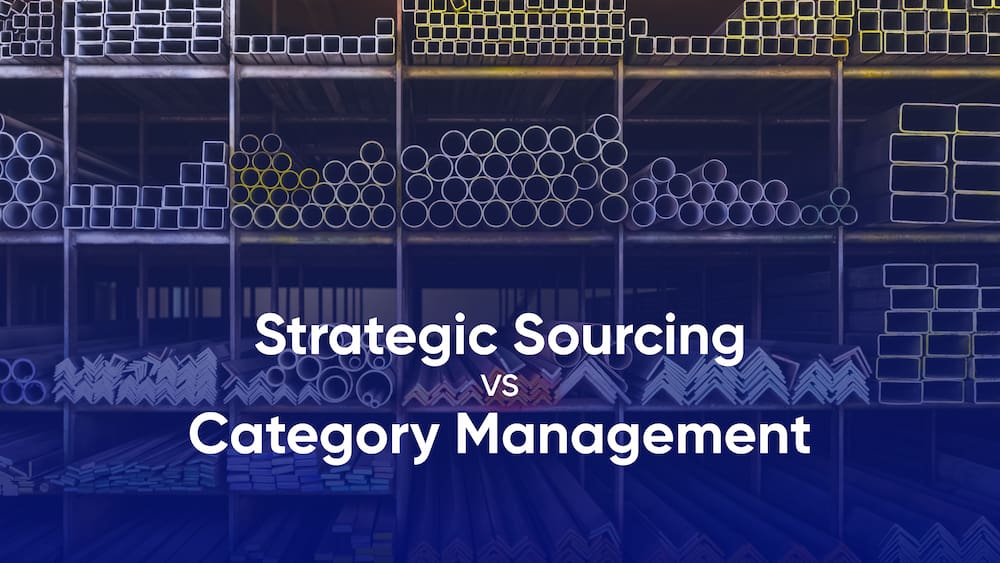In procurement, the terms category management and strategic sourcing are often used interchangeably, but they represent distinct methodologies with unique objectives and benefits. Understanding these differences is crucial for procurement professionals aiming to deliver business and procurement strategies with both immediate and sustained value to their organisations.
This article explores the concepts of category management and strategic sourcing, highlights their key differences, and explains how these approaches complement one another. It also delves into the Kraljic Matrix, a foundational tool for procurement strategy, to contextualise these methods.
- Strategic sourcing focuses on short-term, project-specific goals such as cost savings and supplier selection.
- Category management adopts a long-term, strategic view to optimise value across entire spend categories.
- Kraljic Matrix is a vital tool for deciding when to use each approach, based on supply risk and spend impact.
- Combining these methodologies enables procurement teams to deliver immediate results while driving sustained value.
What Is Strategic Sourcing?
Strategic sourcing is a systematic process aimed at optimising procurement decisions for specific projects or needs. By focusing on detailed data analysis and supplier evaluation, it enables organisations to secure the best value within defined timeframes.
Key Features of Strategic Sourcing
-
Project-focused: Applied to specific procurement events or categories for immediate results.
-
Data-driven: Involves analysing spend patterns, supplier markets and cost structures.
-
Time-bound: Works within a finite timeline, often tied to contract renewals or sourcing initiatives.
-
Goal-oriented: Targets measurable outcomes such as cost savings, supplier consolidation, or risk reduction.
-
Procurement-led: Typically spearheaded by procurement teams, with limited involvement from other departments.
When to Use Strategic Sourcing
Strategic sourcing is ideal for situations requiring immediate attention, such as contract renegotiations, new supplier selection, or for market research and price benchmarking. For example, a company may use strategic sourcing to negotiate a better deal for fleet management services to align with their business strategy to reduce costs.
What Is Category Management?
Category management goes beyond individual procurement events to manage an entire category of spend across the whole organisation or a specific strategic business unit. It aims to align procurement strategies and activities with the business units’ organisational goals, ensuring sustainable value over time.
Category management can go beyond typical strategies such as cost optimisation but also focus on a longer-term, more holistic view in areas such as vendor risk management, supplier management and continuous improvement.
Key Features of Category Management
-
Holistic approach: Focuses on developing a category strategy across the entire lifecycle of a spend category, from sourcing to supplier relationship management.
-
Strategic alignment: Ensures procurement supports broader organisational objectives, such as sustainability or innovation.
-
Continuous process: Unlike strategic sourcing, category management is an ongoing activity.
-
Cross-functional collaboration: Involves stakeholders from various departments to understand and address category-specific needs.
-
Value creation: Looks beyond cost savings to optimise total value, including risk mitigation and supplier innovation.
When to Use Category Management
Category management is best suited for high-value, complex spend categories where long-term planning and market expertise are critical to support business strategy. For instance, managing IT procurement holistically can help align technology investments with the organisation’s digital transformation strategy.
The Kraljic Matrix: A Framework for Procurement Strategy

The Kraljic Matrix, developed by Peter Kraljic in 1983, is a widely used tool for determining procurement strategy based on two key dimensions: supply risk and spend impact. It categorises procurement items into four quadrants:
1. Non-critical items
-
Low supply risk, low spend impact
-
Examples: Office supplies, cleaning products.
-
Recommended approach: Tactical procurement or simple strategic sourcing.
2. Leverage items
-
Low supply risk, high spend impact
-
Examples: Commodities like steel or paper.
-
Recommended approach: Strategic sourcing to drive cost savings through supplier competition.
3. Bottleneck items
-
High supply risk, low spend impact
-
Examples: Specialised components with limited suppliers.
-
Recommended approach: Supplier relationship management and risk mitigation strategies.
4. Strategic items
-
High supply risk, high spend impact
-
Examples: Critical IT systems, unique raw materials.
-
Recommended approach: Category management to ensure long-term value and secure supply continuity.
The Kraljic Matrix helps procurement teams decide when to apply strategic sourcing versus category management. For instance, while leverage items might benefit from a short-term competitive bidding process, strategic items require a comprehensive category management strategy to mitigate risks and maximise value.
Key Differences Between Strategic Sourcing and Category Management
While both approaches aim to optimise procurement, they differ in scope and objectives.
| Aspect | Strategic Sourcing | Category Management |
| Scope | Specific procurement events | Entire spend category |
| Focus | Cost savings and efficiency | Long-term value creation |
| Duration | Project-based, time-bound | Continuous, strategic oversight |
| Stakeholder involvement | Procurement-led | Cross-functional collaboration |
| Examples | Negotiating a contract for IT hardware | Managing all IT procurement over time |
Complementary Roles
Strategic sourcing delivers quick wins, while category management ensures those wins are sustained and integrated into long-term strategies. For example, strategic sourcing may reduce costs for office supplies in the short term, while the category management process often focuses on improving supplier relationships and sustainability practices across the category.
- Personal account manager
- Quality assurance
- Payment terms for companies
- On-time delivery by Fractory
Case Study: Transforming IT Procurement with Strategic Sourcing and Category Management
Scenario: A multinational retailer faced inefficiencies in its IT procurement process. Multiple contracts with software vendors resulted in fragmented spend, high costs and missed renewal deadlines.
Challenge: The company lacked a unified approach to managing IT procurement, limiting its ability to achieve business goals through cost efficiencies or innovation.
Solution: The retailer adopted a dual approach:
-
Strategic sourcing: Ran a tender to consolidate suppliers, securing a single provider for enterprise-wide software licences.
-
Category management: Appointed a category manager to oversee IT procurement, ensuring alignment with the company’s digital transformation goals.
Outcome:
-
Reduced software licensing costs by 20% within six months.
-
Streamlined supplier relationships and improved compliance.
-
Developed a long-term roadmap for IT investments, enabling innovation.
Key Lesson: Combining strategic sourcing with category management enables organisations to achieve immediate cost savings while driving sustainable value.
Implementing Both Approaches
Procurement teams must balance short-term and long-term strategies by integrating strategic sourcing and category management.
Steps to Success
-
Assess spend and risk
Use tools like the Kraljic Matrix to categorise procurement items and decide the appropriate strategy. -
Build expertise
-
Train teams in analytical techniques for strategic sourcing.
-
Appoint experienced category managers with deep market knowledge.
-
-
Leverage technology
Invest in tools that support both approaches, such as spend analytics software and supplier relationship management platforms. -
Collaborate across functions
-
Involve stakeholders in category management to align procurement goals with business objectives.
-
Use feedback from operational teams to inform sourcing strategies.
-
-
Measure outcomes
-
Strategic sourcing: Track cost savings, supplier performance and contract compliance.
-
Category management: Evaluate value creation, risk mitigation and innovation contributions.
-
Ready to Optimise Your Procurement Strategy?
Understanding the nuances between the strategic sourcing process and category management is just the beginning. By applying these concepts and tools like the aforementioned Kraljic Matrix, your organisation can unlock significant value.
Start your transformation today by:
-
Conducting a spend analysis to identify key categories.
-
Exploring tools and platforms to streamline your procurement processes.
-
Training your team on best practices for sourcing and category management.
Further Reading
-
“The Procurement and Supply Manager’s Desk Reference” by Fred Sollish and John Semanik – A comprehensive guide covering both strategic sourcing and category management.
-
“Supply Chain Management: Strategy, Planning, and Operation” by Sunil Chopra – Provides in-depth insights into procurement and sourcing strategies.
-
Peter Kraljic’s original article: “Purchasing Must Become Supply Management”, Harvard Business Review (1983).



